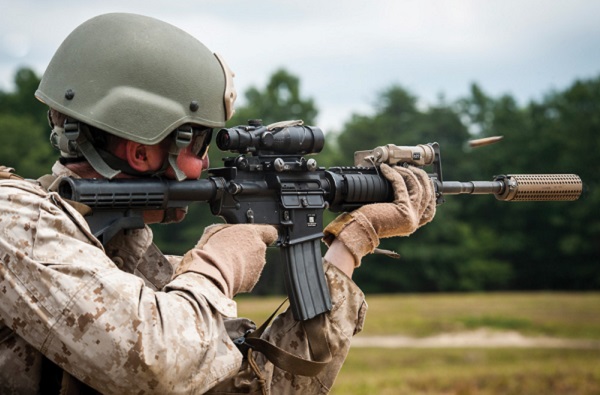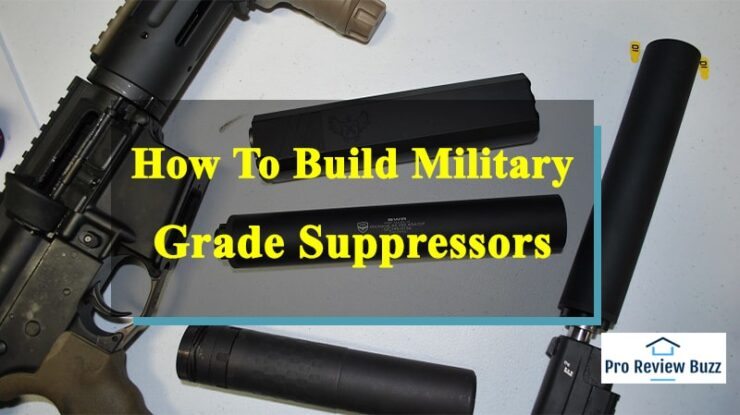Are you planning to build your military-grade suppressor? Then this article “How to build military grade suppressors” will help you build your suppressors. The good thing about making your suppressor is that it costs half the commercial price. For instance, a combination of steel, titanium, and homemade aluminum suppressor will cost $ 150, while a commercial suppressor costs about $ 350.
Moreover, you can choose the design, dimension, and material to use to match your preferences and needs. You will also better understand all the engineering that goes into the suppressor if you build it yourself.
Difference between a Maker and a Manufacturer
If you don’t own a suppressor, it is advisable to purchase from a commercial manufacturer instead of making one yourself.
A maker is an individual or entity (Trust/LLC) approved to build a suppressor for non-commercial use while a manufacturer (FFL/SOTs) is in business to design, build, test, and sell the suppressors.
Here are the differences:
- A maker is not allowed to build a military-grade suppressor to sell but building one for personal use. On the other hand, the manufacturer makes for resale the NFA items.
- The manufacturer can apply for BAFTE variances to particular rules and regulations in the design and build process, while the maker must follow all the BAFTE rules and regulations.
- A maker is not allowed to test or prototype your designs as the manufacturer does.
- Manufacture is allowed to repair damaged military-grade suppressors under specific regulations. On the other hand, makers are not allowed to rectify suppressors, even their own.
What you need to build a military-grade suppressor:
1. Aluminum- the material tends to be lightweight for building machines. It is used on guns or pistol builds with caution.
2. Titanium: it is considered the best metal for building suppressors due to its strength. However, the challenge is the cost which is 5 times the cost of steel and machinability.
3. Stainless steel- since stainless steel is strong but heavy, can be used on any host type. However, you should avoid using it on the end of long gun barrels.
4. Carbon fiber and plastic build- although you can use carbon fiber and plastic, you can consider advanced build.
Note: you can combine the materials when building a military-grade suppressor. For instance, in a pistol suppressor, you can use a titanium tube with steel baffles.
Basic tools to build your suppressor
- Drill
- Drill bits
- Hacksaw to trim extra material
- Files for clipping and grinding baffles and out spacers’
- Heavy-duty hydraulic jack
- Sandpaper for smoothing and polishing
- Cutting oil for drilling and cutting titanium
Things to Keep in Mind When Building your Suppressors
- Costs- when it comes to building a firearm project, it is necessary to compare the price of a well-built commercial suppressor and the cost of making your own.
- Weight- you need to be careful not to overbuild your suppressor. These materials build up at the end of the barrel fast.
- Length- doesn’t make the suppressors too long in the hope of reducing more noise. You should stick to “normal” sizes and measurements.
- Baffles/Monocore- since a maker is not allowed to prototype and test designs. You need to choose either baffle or monocore to get creative internals.
How to Build a Military Grade Suppressor

- Cut a 10-inch piece of the brake line and drill a 1/8″ ventilation hole evenly across its length, starting 1 ½” from the end of the brake line.
- Next, enlarge the holes with a 1/16″drill bit.
- Use masking tape to cover the firearm barrel end and ensure the tape doesn’t wrinkle it while making it tight.
- Set the drill at the barrel end to align the brake line to ensure perfect alignment.
- Wrap the glass mat three times at the barrel end and the brake line. It is fixed using a rubber band at ½”.
- Mix the resin two or three times hotter than the package instructions.
- Hold the gun in an upright position and apply resin on the mat using a brush until it is no longer white but transparent.
- When the resin hardens, detach the brake line and fiberglass from the barrel.
- After the gun barrel has been removed, peel of the tape to allow hardening. Using sandpaper, smooth the rough surfaces.
- Hold the glassed brake line upright in the vise.
- Use an eyedropper to fill in any interior holes or air bubbles with resin until the solid fiberglass is in level with the steel tube end.
- Cut the PVC tubing to the required sizes.
- Drill a large hole in the center of an end cap to secure the fiberglass end where the front sight rests.
- Drill several 3/16″ holes in the bottom of the end cap.
- Wrap a piece of tape around the end cap to seal the holes.
- Place the cap with the inner tube in a vise. Make sure the cap is flush with the brake line.
- Cut 2 dozens of ½” squares of fiberglass mat and fill the end cap with it up past the hole rows’ level.
- Pour resin on the cut mat to ¼” above the holes and let it dry before removing the cap.
- After the inside has hardened, turn the assembly over and fiberglass around the end cap backside to add strength. Set the finished cap and inner tube on one of the PVC pipe ends. Ensure the brake line is at the center when you check through the open end of the PVC.
- Drill a 1/8″hole in the 3 places around the tube about ¼” from the cap’s lip. Remove the brake line out and enlarge the holes to 3/16″. Replace the brake line and tighten it down with 3 wooden screws.
- Sharpen one end of the drill rod to a point and use it as center-punch.
- Use to make the drill bit larger than the brake line’s outside diameter, remove the end cap and drill the hole.
- Cut a circle of ¼”thick rubber to fit snug in the end cap to prevent any hot gasses from escaping even after firing.
- Replace the cap on the open end of the PVC tube and drill a 1/8″hole around the cap
- Push the brake line to stretch the rubber swipe.
- Apply white lithium grease to each wire before inserting it into the suppression tube in a circular motion.
- Replace the end cap with 3 screws.
- Paint the finished suppressor flat black and attach it to your firearm.
Frequently Asked Questions
Are solvent traps legal?
Owning a solvent trap is legal. You don’t need to file any ATF paperwork since it is not controlled under federal gun law. It is not considered an NFA item, such as a suppressor.
Do you need paperwork to build a suppressor?
Yes. Since the suppressor is an NFA item, you need to fill out the paperwork for a background check with the ATF before building it.
Can I use aluminum to build my suppressor?
Yes, aluminum is recommended for .22 LR guns and handgun cartridges. It works well with low-velocity rifle cartridges, including subsonic 300 BLK.
Where can you get more information on building specifications, baffle, or machining?
You can use Silencersmithing Section to get information since it has more resources and images on building a military-grade suppressor.
Conclusion
You need an approved Form 1 before starting to build a military-grade suppressor. You can purchase the required parts to make a suppressor as you wait for Form 1 to be approved. The components can be bought from metal supply sources, hardware stores, auto parts stores, or a machine shop. After Form 1 is approved, you need to purchase metal tubes, form the baffle cones, and drill boreholes.

